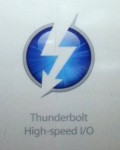My experience using USB 3.0 on a Mac has been wonderful. It’s so well-integrated you might not notice it except for the performance. At over 200 MB/s, it blows FireWire out of the water and is even faster than nearly any device you’re likely to throw at it. CalDigit sent me their Mac OS X-compatible USB 3.0 PCI Express card for evaluation, and I’m pleased as punch with the card.
USB
Will Apple Call Light Peak “Thunderbolt”?
Intel has been incredibly tight-lipped about Light Peak. Although I’ve been hounding my contacts inside the company for months, no one has spilled the beans about anything. All I know about Light Peak I learned on the Internet, as they say. Now comes another bombshell: Apple will introduce Light Peak-equipped MacBook Pros tomorrow (February 24) with “Thunderbolt”, a high-speed I/O port!
Infographic: Real-World Port Throughput Relative To Thunderbolt (Formerly Light Peak)
Just how fast is 10 gigabits per second anyway? To help out, I’ve prepared another napkin-tastic infographic!
Why Won’t My MiFi Charge?
The MiFi 2200 requires a special charging cable. The bundled charger works, but normal folks (like me) might assume that any Micro-USB cable will work. They would be wrong.
What If Light Peak Was Electrical Rather Than Optical?
As I considered the possibilities of the new Apple/Intel interconnect technology known as Light Peak, an odd parallel with 10 Gb Ethernet popped into my head. Much of the confusion around Light Peak revolves around connectors, power conduction, and backward-compatibility. Then, like the Grinch, I thought of something I hadn’t before: Why use optical at all? 10 GBASE-T does just fine over twisted pair, and short interconnect distances would reduce power draw to reasonable levels. What if Light Peak was electrical rather than optical?



